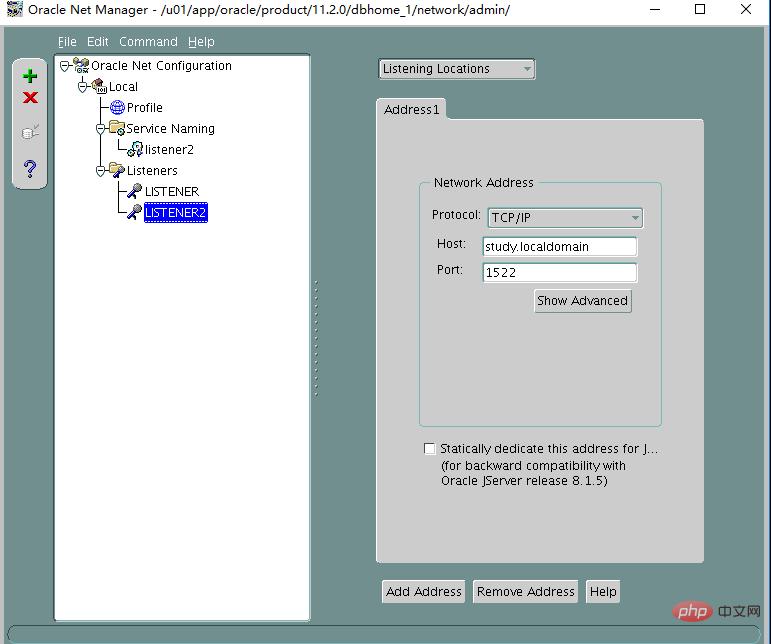What is oracle monitoring
Oracle monitoring is a server-side process that is responsible for monitoring requests from clients and can establish data links between the client computer and the database computer. After receiving the request, Oracle monitoring derives a server process to provide services. Database configuration provides both private and shared modes.

The operating environment of this tutorial: Windows 10 system, Oracle 11g version, Dell G3 computer.
What is oracle monitoring
Oracle monitoring is a server-side process responsible for monitoring requests from clients
The listener does not need to reside on the database host, that is, You can register the instance to the monitor on the remote host
The monitor is Oracle's own software or component
Local connections do not need to monitor, but remote connections must
oracle After listening to the request sent by the user process, a server process is derived to provide services. The server process has two modes according to the configuration of the database: proprietary mode and shared mode
Private mode: each client process There is a separate server process to establish a session to provide services. Most of more than 99% of databases are in this mode
Shared mode: There is a dispatcher called dispatch, which monitors and puts requests into the request queue. Dispatch will continuously query the request queue. When a request is found, it will transfer the request to the server process, and then provide services through the server process. After processing, it will feed back to the response queue. Dispatch will then forward the response queue to the user process. Similar to eating in a restaurant, the server process is equivalent to the chef, and dispatch is equivalent to the waiter. The waiter accepts the request and forwards it to the corresponding idle chef to provide service. Wherever the chef puts the dishes prepared, the waiter then serves them to the customer; this model is not used. After multiple
dbca databases are built, there will usually be a default monitor. There is no need to configure it. The default service port of the monitor is 1521.
Generally, one monitor is enough for a database, but if the concurrency is too large, it may be necessary. Configure multiple monitors. The non-default monitor port number is greater than 1024. The service name and port number between different monitors cannot be the same.
How to distinguish different libraries from monitors, so you need to register the instance as a service and register it to In listen,
Registration is to add the instances running on the host to the listener, so that the listener knows which instances are on the host
Configuration method
Dynamic registration
There are two types of service registration, one is dynamic registration, which actively and automatically registers the instance into the listen through the pmon process
Listening and instance In the startup sequence, when the monitor starts first, there is no problem. If it starts after the monitor, you can manually alter system register to register it, or leave it alone, pmon will register it after a while.
Generally, the default monitor is dynamic registration
No need for listener.ora file
The service status has the words status READY (library is in mount or open state)
pmon provides the instance name, service name, and service to the listener The type and address of the handler
The registered service names are db_name.db_domain, db_nameXDB.db_domain
If you want pmon to register to a non-default listener, you must configure the local_listener parameter

Configuring listening can be configured through netca graphics or command configuration

The default listening name is LISTENER. The configuration is as above. In fact, there is no such listener.ora, the default listen can also run normally, so let's add a non-default dynamic listener on port 1522, named listener2
First add a listener to the netmgr graphic

Or edit listener.ora to add a listener.

Then modify tnsnames.ora to add a listener2 string to modify the local_listener parameter (that is, change the listener Copy the section in to tnsnames.ora)

Set the local_listener parameter and register it manually,
[oracle@study admin]$ sql SQL*Plus: Release 11.2.0.1.0 Production on Thu Sep 19 17:07:41 2019 Copyright (c) 1982, 2009, Oracle. All rights reserved. Connected to: Oracle Database 11g Enterprise Edition Release 11.2.0.1.0 - 64bit Production With the Partitioning, OLAP, Data Mining and Real Application Testing options 17:07:42 SYS@study> show parameter local_list NAME TYPE VALUE ------------------------------------ ----------- ------------------------------ local_listener string 17:08:19 SYS@study> alter system set local_listener='LISTENER2'; System altered. Elapsed: 00:00:00.04 17:09:03 SYS@study> alter system register; System altered. Elapsed: 00:00:00.00 17:09:21 SYS@study> Disconnected from Oracle Database 11g Enterprise Edition Release 11.2.0.1.0 - 64bit Production With the Partitioning, OLAP, Data Mining and Real Application Testing options [oracle@study admin]$ lsnrctl status listener2 LSNRCTL for Linux: Version 11.2.0.1.0 - Production on 19-SEP-2019 17:10:22 Copyright (c) 1991, 2009, Oracle. All rights reserved. Connecting to (DESCRIPTION=(ADDRESS=(PROTOCOL=TCP)(HOST=study.localdomain)(PORT=1522))) STATUS of the LISTENER ------------------------ Alias listener2 Version TNSLSNR for Linux: Version 11.2.0.1.0 - Production Start Date 19-SEP-2019 16:38:16 Uptime 0 days 0 hr. 32 min. 6 sec Trace Level off Security ON: Local OS Authentication SNMP OFF Listener Parameter File /u01/app/oracle/product/11.2.0/dbhome_1/network/admin/listener.ora Listener Log File /u01/app/oracle/diag/tnslsnr/study/listener2/alert/log.xml Listening Endpoints Summary... (DESCRIPTION=(ADDRESS=(PROTOCOL=tcp)(HOST=study.localdomain)(PORT=1522))) Services Summary... Service "study" has 1 instance(s). Instance "study", status READY, has 1 handler(s) for this service... Service "studyXDB" has 1 instance(s). Instance "study", status READY, has 1 handler(s) for this service... The command completed successfully [oracle@study admin]$
But in this case, the default is pmon It will not be registered in the default monitor, that is, it cannot be accessed from 1521. If you want 1521 and 1522 to provide services at the same time, you can delete the default monitor and change the configuration to
LISTENER2 =
(DESCRIPTION =
(ADDRESS = (PROTOCOL = TCP)(HOST = study.localdomain)(PORT = 1522))
(ADDRESS = (PROTOCOL = TCP)(HOST = study.localdomain)(PORT = 1521))
)Since dynamic monitoring depends on PMON, delete the monitor Configuration file, the default listening is still valid, and the monitoring is still listening to localhost:1521. The LOCAL_LISTENER parameter controls where the instance dynamically registers itself. The default value of the LOCAL_LISTENER parameter is (ADDRESS = (PROTOCOL=TCP)(HOST=hostname)(PORT= 1521)), PMON still actively registers instances to listen. This is the registration method by default after dbca database is created.
It can be seen that dynamic monitoring requires that the monitoring and local_listener parameter configurations are consistent, and they are all empty by default. The configuration is the default monitoring. If it is not the default, just display and configure these two places
tnsnames
.ora在动态监听中不是必须的,只是为了配置个本地的字符串方便local_listener的配置命令而已,直接配置如下形式也ok
alter system set local_listener='(ADDRESS=(PROTOCOL=TCP)(HOST=study.localdomain)(PORT=1521))'; 等同于alter system set local_listener='';
配置注册到多个监听,可以如下
alter system set local_listener='(ADDRESS=(PROTOCOL=TCP)(HOST=study.localdomain)(PORT=1521))','(ADDRESS=(PROTOCOL=TCP)(HOST=study.localdomain)(PORT=1522))';
或者先在tnsnames.ora中配置多个地址的字符串

再设置alter systemset local_listener='LISTENER2';
在共享服务器模式下,可以配置listener的一个参数叫做dispatchers,把这个分派器注册到一个非默认监听
ALTER SYSTEM SET DISPATCHERS=”(PROTOCOL=tcp)(LISTENER=lsnr2)”;

select service_id,name from vactiveservices可以查出,前面2个服务是注册到监听的,后面2个是Oracle有两个内部的服务,SYSBACKGROUND是后台进程使用的,SYS$USERS提供给没有指定服务的用户会话使用

service_names是服务名,如果为空,会把db_name.db_domain 注册到监听
推荐教程:《Oracle视频教程》
The above is the detailed content of What is oracle monitoring. For more information, please follow other related articles on the PHP Chinese website!

Hot AI Tools

Undresser.AI Undress
AI-powered app for creating realistic nude photos

AI Clothes Remover
Online AI tool for removing clothes from photos.

Undress AI Tool
Undress images for free

Clothoff.io
AI clothes remover

Video Face Swap
Swap faces in any video effortlessly with our completely free AI face swap tool!

Hot Article

Hot Tools

Notepad++7.3.1
Easy-to-use and free code editor

SublimeText3 Chinese version
Chinese version, very easy to use

Zend Studio 13.0.1
Powerful PHP integrated development environment

Dreamweaver CS6
Visual web development tools

SublimeText3 Mac version
God-level code editing software (SublimeText3)

Hot Topics
 What to do if the oracle can't be opened
Apr 11, 2025 pm 10:06 PM
What to do if the oracle can't be opened
Apr 11, 2025 pm 10:06 PM
Solutions to Oracle cannot be opened include: 1. Start the database service; 2. Start the listener; 3. Check port conflicts; 4. Set environment variables correctly; 5. Make sure the firewall or antivirus software does not block the connection; 6. Check whether the server is closed; 7. Use RMAN to recover corrupt files; 8. Check whether the TNS service name is correct; 9. Check network connection; 10. Reinstall Oracle software.
 How to solve the problem of closing oracle cursor
Apr 11, 2025 pm 10:18 PM
How to solve the problem of closing oracle cursor
Apr 11, 2025 pm 10:18 PM
The method to solve the Oracle cursor closure problem includes: explicitly closing the cursor using the CLOSE statement. Declare the cursor in the FOR UPDATE clause so that it automatically closes after the scope is ended. Declare the cursor in the USING clause so that it automatically closes when the associated PL/SQL variable is closed. Use exception handling to ensure that the cursor is closed in any exception situation. Use the connection pool to automatically close the cursor. Disable automatic submission and delay cursor closing.
 How to create cursors in oracle loop
Apr 12, 2025 am 06:18 AM
How to create cursors in oracle loop
Apr 12, 2025 am 06:18 AM
In Oracle, the FOR LOOP loop can create cursors dynamically. The steps are: 1. Define the cursor type; 2. Create the loop; 3. Create the cursor dynamically; 4. Execute the cursor; 5. Close the cursor. Example: A cursor can be created cycle-by-circuit to display the names and salaries of the top 10 employees.
 How to stop oracle database
Apr 12, 2025 am 06:12 AM
How to stop oracle database
Apr 12, 2025 am 06:12 AM
To stop an Oracle database, perform the following steps: 1. Connect to the database; 2. Shutdown immediately; 3. Shutdown abort completely.
 What steps are required to configure CentOS in HDFS
Apr 14, 2025 pm 06:42 PM
What steps are required to configure CentOS in HDFS
Apr 14, 2025 pm 06:42 PM
Building a Hadoop Distributed File System (HDFS) on a CentOS system requires multiple steps. This article provides a brief configuration guide. 1. Prepare to install JDK in the early stage: Install JavaDevelopmentKit (JDK) on all nodes, and the version must be compatible with Hadoop. The installation package can be downloaded from the Oracle official website. Environment variable configuration: Edit /etc/profile file, set Java and Hadoop environment variables, so that the system can find the installation path of JDK and Hadoop. 2. Security configuration: SSH password-free login to generate SSH key: Use the ssh-keygen command on each node
 Oracle's Role in the Business World
Apr 23, 2025 am 12:01 AM
Oracle's Role in the Business World
Apr 23, 2025 am 12:01 AM
Oracle is not only a database company, but also a leader in cloud computing and ERP systems. 1. Oracle provides comprehensive solutions from database to cloud services and ERP systems. 2. OracleCloud challenges AWS and Azure, providing IaaS, PaaS and SaaS services. 3. Oracle's ERP systems such as E-BusinessSuite and FusionApplications help enterprises optimize operations.
 What to do if the oracle log is full
Apr 12, 2025 am 06:09 AM
What to do if the oracle log is full
Apr 12, 2025 am 06:09 AM
When Oracle log files are full, the following solutions can be adopted: 1) Clean old log files; 2) Increase the log file size; 3) Increase the log file group; 4) Set up automatic log management; 5) Reinitialize the database. Before implementing any solution, it is recommended to back up the database to prevent data loss.
 How to create oracle dynamic sql
Apr 12, 2025 am 06:06 AM
How to create oracle dynamic sql
Apr 12, 2025 am 06:06 AM
SQL statements can be created and executed based on runtime input by using Oracle's dynamic SQL. The steps include: preparing an empty string variable to store dynamically generated SQL statements. Use the EXECUTE IMMEDIATE or PREPARE statement to compile and execute dynamic SQL statements. Use bind variable to pass user input or other dynamic values to dynamic SQL. Use EXECUTE IMMEDIATE or EXECUTE to execute dynamic SQL statements.






